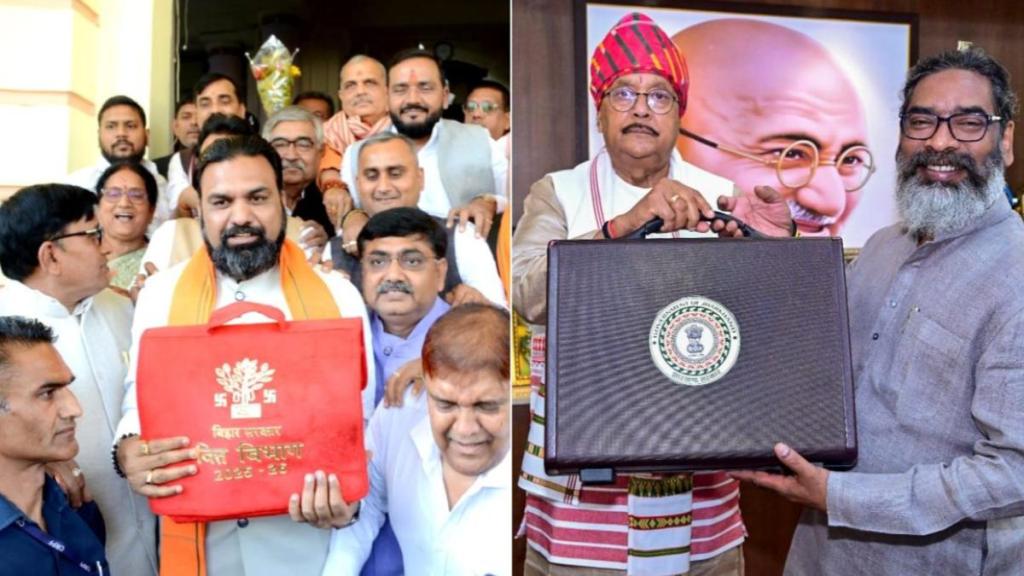With Bihar elections on the horizon, the Nitish Kumar-led government presented a comprehensive Rs 3.17 lakh-crore budget on Monday. The budget puts focus on women’s empowerment, infrastructure, farmer support and student welfare related schemes. The budget, Rs 38,169 crore higher than the previous fiscal, was presented by Deputy Chief Minister Samrat Choudhary, who credited PM Narendra Modi’s ‘margdarshan’ and the CM’s ‘netritva’ for its vision.
Highlights from Bihar Budget 2025-26
The state government has placed a strong focus on women’s welfare, announcing several initiatives. ‘Kanya Vivah Mandaps’ will be established in every panchayat to assist with marriage ceremonies for poor girls. In Patna, a ‘Mahila Haat’ (women’s marketplace) will be set up, and vending zones across major cities will have reserved spaces for women. Additionally, dedicated ‘Pink Buses’ exclusively for women, operated by female drivers and conductors, will run in key urban centers, while ‘Pink Toilets’ — 20 of which will be constructed within a month — will improve sanitation facilities for women.
To support working women, hostels will be built in major cities. The government has also announced a 33% job reservation for women in the Bihar State Road Transport Corporation and subsidies for women purchasing e-rickshaws. ‘Gym-on-Wheels’, featuring female trainers, will be launched in Patna.
Education has received the highest allocation of Rs 60,964 crore. The scholarship for students from Class 1 to 10 will be doubled from Rs 1,000 to Rs 2,000 per month. The government also announced plans to open at least one degree college in all 534 blocks of the state.
Healthcare has been allocated Rs 20,335 crore, while Rs 17,831 crore will go to the home department to strengthen law and order. Infrastructure improvements include greenfield airports in Sultanganj (Bhagalpur) and Raxaul (East Champaran), with Purnea Airport set to become operational within three months. A dedicated cancer hospital has been proposed for Begusarai district.
For farmers, the state government will collaborate with NEFED and the National Cooperative Consumer Federation (NCCF) to fix a minimum support price for pulses. Meanwhile, Rs 13,368.47 crore has been allocated for the welfare of SC/ST, OBC, minorities and most backward classes.
Jharkhand’s Hemant Soren-led government also presented a Rs 1.45 lakh-crore budget today, allocating Rs 62,844 crore for social welfare programs aimed at women, the poor and vulnerable groups. Finance Minister Radhakrishna Kishore projected a 7.5% economic growth rate for the state in the 2025-26 fiscal year.
Highlights from Jharkhand Budget 2025-26
The budget earmarked Rs 13,363 crore for the Jharkhand Mukhyamantri Maiya Samman Yojana, a financial assistance scheme for women aged 18-50. Another Rs 5,000 crore has been set aside for free electricity to benefit households.
To boost industrial growth, the government aims to attract Rs 20,000 crore in investments, generating 15,000 direct and indirect jobs. Tourism will be a key focus, with heli-shuttle services planned from Ranchi to Deoghar, Basukinath, Rajrappa, Itkhori and tourist destinations like Betla National Park and Patratu Valley. The state will construct glass bridges at popular sites and set up ropeways in Jonha, Hundru, Kauleshwari and Trikut. Rs 336.64 crore has been allocated to the tourism sector.
Education and healthcare also received significant boosts. An amount of Rs 15,198.35 crore has been allotted for primary and secondary education, Rs 2,409.20 crore for higher and technical education and Rs 7,470.50 crore for healthcare. The state plans to establish two new universities, five law colleges and six medical colleges. Additionally, vocational education will be promoted through the establishment of a fintech university and schools of business and mass communication in key districts.
For legal studies, new law colleges will be opened in Ranchi, Hazaribag, Dhanbad, Dumka and Palamu. Infrastructure development in the state will be complemented by a strong push toward revenue generation through tourism and industrial growth.
(With inputs from agencies)


